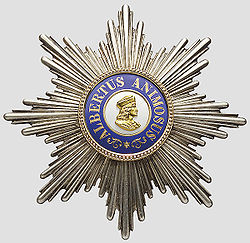- Albert Order
-
Albert Order
(Albrechts-Orden)
Star of the orderAwarded by  Kingdom of Saxony
Kingdom of SaxonyType Military Order of Merit Eligibility Saxon civilians and military officers Awarded for service to the state for civil virtue, science, art and after 1860 the military Status Obsolete Statistics Established 31 December 1850 Last awarded 1918 Precedence Next (higher) Military Order of St. Henry Next (lower) Civil Order of Saxony
Ribbon of the orderThe Albert Order (German: Albrechts-Orden) was created 31 December 1850 by King Frederick Augustus II of Saxony to commemorate Albert III, Duke of Saxony (known as Albert the Bold) and was to be awarded to anyone who had served the state well, for civil virtue, science and art.[1]
Design
The design was a Christian cross with a bust of Albert the Bold at the centre. In 1875, however, it was discovered the bust was in fact the wrong Albert, Albert the Perennial, and the correct image was substituted and used thereafter.[2]
Grades
At first, there were five classes : Great Cross (Großkreuz), Commander's Cross Class I (Komturkreuz I), Commander's Cross Class II (Komturkreuz II), Knight's Cross (Ritterkreuz) and Small Cross (Kleinkreuz). These provided the basis for a series of changes over the following forty years. In 1858, the Small Cross was renamed as the Honour Cross (Ehrenkreuz) and a sixth class was established with a golden and silver Merit Medal (Verdienstmedaille). A Merit Cross (Verdienstkreuz) with Swords was added in 1866 and this was extended in 1870 with the Merit Cross with Swords on Ring.[1]
The medals were abolished in 1876 and the Knights Cross was divided into two classes. In 1884, a gold Great Cross was added and in 1890, the Officer's Cross was inserted into the Order above the Knight's Cross.[1]
An award of Swords indicated a recipient's bravery in wartime. If, however, a recipient was subsequently awarded a higher grade in the Order, he could lose the bravery distinction attached to the superseded grade (regulations only allowed the display of the insignia of the highest awarded grade). This anomaly was solved in 1906 by allowing the addition of Swords by replacement of insignia. A recipient, however, had to pay the cost of replacement and this appears to have inhibited the numbers of such replacements.[3]
References
- ^ a b c Gareis, Frank (1997-2003). "Kingly Saxon Albrecht-Order". http://www.gaes.de/e-orden.html. Retrieved 19 June 2010.
- ^ Schulze Ising, Andreas M. (2005). "Manufacturers of the Saxon Albert Order". Imperial German Orders, Decorations and Medals. http://www.medalnet.net/Albert_Manufacturers.htm. Retrieved 19 June 2010.
- ^ Schulze Ising, Andreas M. (2005). "The Saxon Albert Order with Swords on Ring". Imperial German Orders, Decorations and Medals. http://www.medalnet.net/albert_swords_on_ring.htm. Retrieved 19 June 2010.
Categories:- Orders, decorations, and medals of Saxony
Wikimedia Foundation. 2010.
